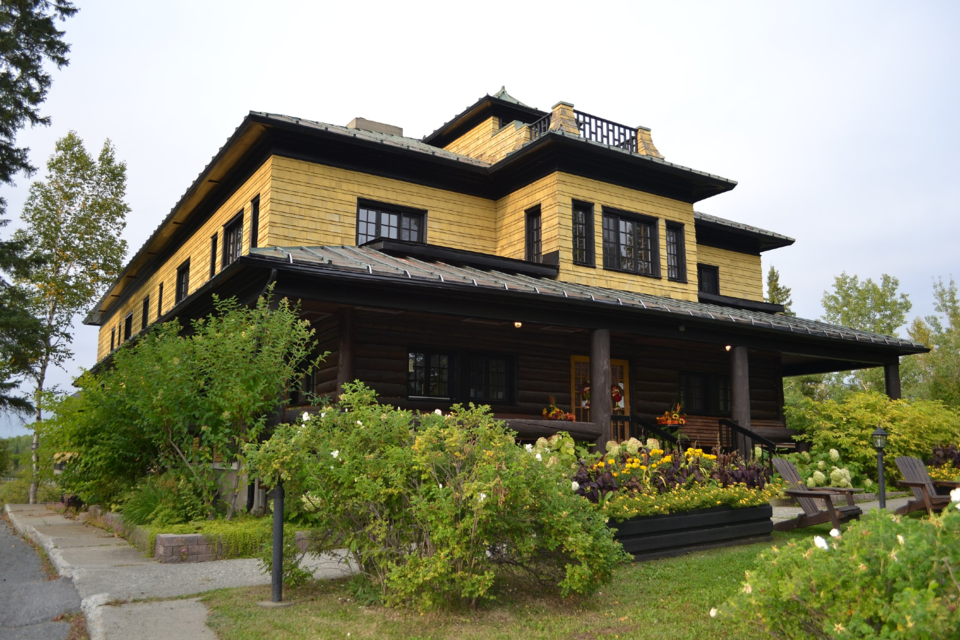Much has been said recently about the Sir Harry Oakes Chateau in Kirkland Lake.
Owned by the Ontario Heritage Trust and operated by the Town of Kirkland Lake, the chateau is a monument commemorating the early days of the Northern Ontario gold rushes, the prospectors who made the discoveries and the men who developed the mines and the communities in the region. Since 1983, the Museum of Northern History, which originally lived in the assay office of the Wright-Hargreaves Mine, has been housed in Sir Harry’s former abode.
The chateau was built in 1929 after Sir Harry’s original Kirkland Lake house was destroyed by fire. The copper roof and the craftsman and shingle style design are impressive. The home also boasts a six-car garage with a drive-through basement (I assume he was a car nut). The house was used primarily when Sir Harry and his family were visiting town, his mining properties and interests. His permanent residence was Oak Hall, a 37-room, Tudor-style, three-storey monstrosity-of-a-mansion in Niagara Falls (now serving as the headquarters for the Niagara Parks Commission, since 1982).
So, who was this Northern Ontario big-wig, and why is his story still talked about today?
Well, to begin with, Harry Oakes is recognized by the Canadian Mining Hall of Fame as “the self-made prospector and mine-finder who transformed Ontario’s Kirkland Lake district into one of the world’s most famous gold camps. His outstanding achievement was the discovery and development of the Lake Shore mine, the first significant find in that area”. The Lake Shore mine was the largest producer in the Kirkland Lake camp and was considered, at one time, one of the richest gold producers in the Western Hemisphere. Between 1918 and 1965, the mine produced about eight million ounces of gold.
Harry Oakes was born in Sangerville, Maine, in 1874. He was well educated, attending Foxcroft Academy, Bowdoin College and the Syracuse Medical School — but he was seduced by the lure of the Klondike in 1899, and prospecting became his passion. His search for gold took him from the Yukon to Alaska, New Zealand, Australia, the Philippines, Mexico, Africa and back to the American West where he heard about the silver discoveries in Cobalt and the gold finds in the Porcupine. He hurried back in 1910 but was disappointed to find both areas heavily staked with no claims available for miles. Armed with about $2 in his pocket, Oakes headed to the Swastika area on a tip, being the lucky man that he was, he found gold-bearing porphyry on the south shore of Kirkland Lake and he staked the area.
Oakes continued his exploration work and was grubstaked by Tom and George Tough, which allowed him to continue the hunt. By the end of 1912, the Tough-Oakes Mine (later the Toburn) was in operation. Money from that operation allowed Oakes to go back to his original find and sink a shaft. The initial findings were bleak but Oakes was convinced there was something to pursue. He formed the Lake Shore Mines Company to raise funds to continue with the hard work of exploration. His tenacity finally paid off in 1918 when workers hit a major vein (the “main break”) and the Lake Shore mine made Oakes a multi-millionaire — and Kirkland Lake a new northern mining town.
Oakes would go on to be recognized as a brilliant and generous man. He split his time between Kirkland Lake and Niagara Falls, but by 1934, moved his family to the Bahamas to escape the crippling tax bill imposed on him by R.B. Bennett’s Conservative government (85 per cent of his gold mine revenue in taxes, Oakes claimed it cost him $17,500 a day in tax to live in Canada). He put his money to good use in his new tropical home, contributing to the building of the Nassau Airport and the Hilton Hotel. King George VI made him a Baronet of the United Kingdom in 1939, in recognition of his philanthropic activities.
Enjoying his time as one of the richest men in the British Empire (and a regular dinner guest of the Duke and Duchess of Windsor, then Governor of the Bahamas), Sir Harry is credited with kick-starting the sluggish Bahamian economy with investments that would stimulate the burgeoning tourist trade in the Caribbean.
But it all came to a crashing end on July 7, 1943, when Sir Harry Oakes was brutally murdered in his bed at his Nassau estate. Discovered by Harold Christie, a family friend who just happened to be staying in the mansion overnight, Sir Harry had been bludgeoned (or shot, depending on whose testimony you believe) and then set on fire while he slept. Christie claimed not to have heard or seen anything.
The bizarre murder method, the botched investigation, the arrest of his son-in-law (and his subsequent acquittal), the fact Christie was never a suspect, the manipulation of the trial by the Duke of Windsor and the failure to find the person or persons responsible for the death of the richest man in the Bahamas has created one of the world’s best unsolved crime stories. And to think it all started right here in the North.
